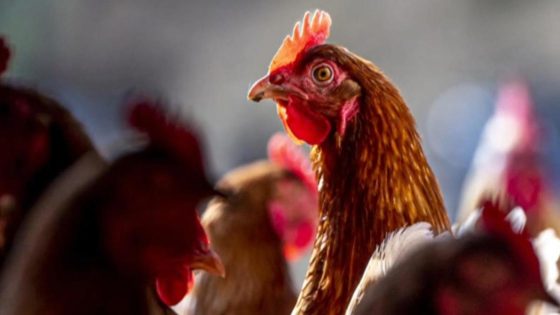Have high blood pressure? This high-protein meal plan can help.

Reviewed by Dietitian Jessica Ball, M.S., RDReviewed by Dietitian Jessica Ball, M.S., RD
For most people, blood pressure has no noticeable symptoms but that doesn’t mean it shouldn’t be taken seriously. Having high blood pressure, also called hypertension, increases the risk of stroke and heart disease—two leading causes of death in the United States. If you’re one of the nearly 50% of adults in the United States with high blood pressure, you may be wondering what steps you can take to protect your heart. While there are many potential causes of high blood pressure, including genetics, there are lifestyle and nutrition changes that may help improve your levels. Follow this high-protein meal plan for high blood pressure to get started.
How We Create Meal Plans
Registered dietitians thoughtfully create EatingWell’s meal plans to be easy-to-follow and delicious. Each meal plan meets specific parameters depending on the health condition and/or lifestyle goal it is targeting and is analyzed for accuracy using the nutrition database, ESHA Food Processor. As nutritional needs differ from person to person, we encourage you to use these plans as inspiration and adjust as you see fit.
Why This Meal Plan Is Great for You
To help improve blood pressure, we limit nutrients that may worsen your levels and prioritize nutrients that can help. We limit sodium to 1,500 milligrams per day, which is the max the American Heart Association (AHA) recommends for people with high blood pressure. We also limit saturated fat to no more than 14 grams per day, as the AHA recommends limiting saturated fat for overall heart health and prioritizing unsaturated fats from foods like nuts, fish and olive oil.
To help improve blood pressure, we include a wide array of high-potassium foods. Potassium helps reduce tension in the blood vessels and counteracts the impact of sodium, both of which can help improve blood pressure. The AHA recommends a potassium intake of 3,500 to 5,000 milligrams of potassium per day to help prevent and treat high blood pressure. Each day in this meal plan provides an average of 3,890 milligrams of potassium to align with these recommendations. Because of its numerous health benefits, including improving heart health, we include plenty of high-fiber foods from sources such as beans, lentils, whole grains, fruits and vegetables. Each day provides an average of 41 grams per day. Though there’s not a lot of evidence on the impact a high-protein diet has on high-blood pressure, we know that it’s a nutrient that many people prioritize. Each day provides an average of 106 grams of protein per day.
This 1,800-calorie meal plan has modifications for 1,500 and 2,000 calories to support those with different calorie needs. While we previously included meal plans and modifications for 1,200 calories, we no longer do. The 2020-2025 Dietary Guidelines for Americans suggests that limiting your calories to 1,200 per day is too low for most people to meet their nutritional needs, plus it’s unsustainable for long-term health and well-being.
Frequently Asked Questions
Is it OK to mix and match meals if there is one I do not like?
Definitely, feel free to repeat a different meal if there’s one you don’t like or choose a different high-protein, heart-healthy dinner. For reference, we aimed for 1,800 calories per day and a daily minimum of 90 grams of protein and 30 grams of fiber—though most days came in quite a bit higher than that. We capped sodium at 1,500 milligrams per day and saturated fat at 14 grams per day. We have a wide array of heart-healthy recipes, so you can find something to suit your tastes.
Can I eat the same breakfast or lunch every day?
Yes, if it’s easier to eat the same breakfast or lunch every day then that works! Each breakfast is between 368 to 424 calories while each lunch spans 369 to 589 calories. If you’re closely monitoring calories, protein or other nutrients, you may want to adjust a snack or two.
Why is there not a modification for 1,200 calories?
We no longer provide modifications for 1,200-calorie days in our meal plans. The 2020-2025 Dietary Guidelines for Americans suggests that limiting calories to 1,200 per day is too low for most people to meet their nutritional needs, plus it’s unsustainable for long-term health and well-being.
What are the side effects of high blood pressure?
Though it often has no symptoms, blood pressure can cause some serious side effects. Untreated high blood pressure damages and hardens the blood vessels. It increases the risk for heart disease, heart attack and stroke as well as kidney and eye damage.
Protein and Blood Pressure:
Though the impact of total dietary protein intake on blood pressure is unclear, there is evidence that links eating a wide variety of protein sources with a reduced onset of high blood pressure. Researchers evaluated the variety and quantity of protein intake of over 12,000 adults in China. The participants who ate protein from the widest variety of sources had a reduced risk of developing high blood pressure. That’s some serious motivation to proiritize the satisfying macronutrient. Enjoy protein from sources such as poultry, fish, shellfish, dairy, nuts, seeds, soy and legumes.
Foods to Focus On:
-
Beans and lentils
-
Dairy, particularly yogurt, kefir and cottage cheese
-
Poultry
-
Lean meat
-
Fish
-
Shellfish
-
Nuts, seeds and nut butters
-
Soy (tofu, edamame)
-
Fruits
-
Vegetables
-
Whole Grains
-
Olive oil
-
Avocado
-
Herbs and spices
How to Meal-Prep Your Week of Meals:
-
Make High-Protein Peanut Butter, Banana & Blueberry Overnight Oats to have for breakfast on days 2 through 4.
-
Prepare Baked Banana-Nut Oatmeal Cups to have as a snack throughout the week.
Day 1
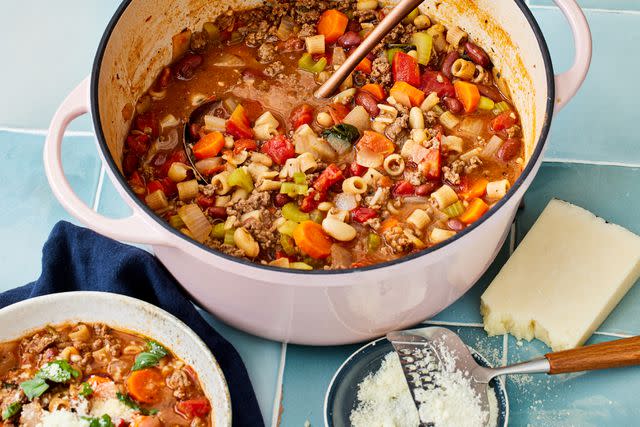

Photographer: Robby Lozano, Food Stylist: Margaret Dickey, Prop Stylist: Julia Bayless
Breakfast (424 calories)
A.M. Snack (135 calories)
-
½ cup edamame, in pods
-
1 clementine
Lunch (589 calories)
P.M. Snack (261 calories)
Dinner (404 calories)
Meal-Prep Tip: Reserve 3 servings Copycat Olive Garden Pasta e Fagioli to have for lunch on days 2 through 4.
Daily Totals: 1,812 calories, 76g fat, 13g saturated fat, 103g protein, 198g carbohydrate, 44g fiber, 1,447mg sodium, 4,109mg potassium
Make it 1,500 calories: Omit edamame at A.M. snack, reduce to ¾ cup yogurt and omit walnuts at lunch and omit kefir at P.M. snack.
Make it 2,000 calories: Add ¼ cup dry-roasted unsalted almonds as an evening snack.
Day 2
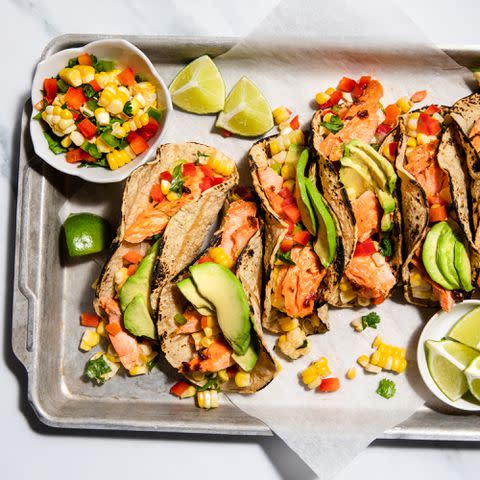

Breakfast (419 calories)
A.M. Snack (281 calories)
Lunch (369 calories)
P.M. Snack (261 calories)
Dinner (460 calories)
Daily Totals: 1,790 calories, 61g fat, 11g saturated fat, 98g protein, 233g carbohydrate, 38g fiber, 1,336mg sodium, 3,955mg potassium
Make it 1,500 calories: Change A.M. snack to 1 medium orange and omit kefir at P.M. snack.
Make it 2,000 calories: Add ¼ cup dry-roasted unsalted almonds as an evening snack.
Day 3
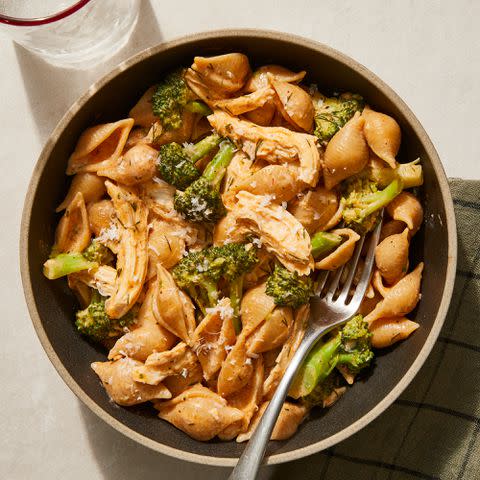

Breakfast (419 calories)
A.M. Snack (105 calories)
Lunch (402 calories)
P.M. Snack (265 calories)
Dinner (530 calories)
Evening Snack (62 calories)
Daily Totals: 1,782 calories, 50g fat, 13g saturated fat, 106g protein, 244g carbohydrate, 37g fiber, 1,489mg sodium, 3,546mg potassium
Make it 1,500 calories: Change A.M. snack to 1 plum, omit apple at lunch and omit yogurt at P.M. snack.
Make it 2,000 calories: Add 2 Tbsp. natural peanut butter to banana at the A.M. snack.
Day 4


Breakfast (419 calories)
A.M. Snack (105 calories)
Lunch (402 calories)
P.M. Snack (268 calories)
Dinner (432 calories)
Evening Snack (179 calories)
Daily Totals: 1,805 calories, 71g fat, 11g saturated fat, 104g protein, 204g carbohydrate, 40g fiber, 1,444mg sodium, 3,530mg potassium
Make it 1,500 calories: Omit almonds at P.M. snack and omit chopped walnuts and blueberries at evening snack.
Make it 2,000 calories: Add 2 Tbsp. natural peanut butter to banana at the A.M. snack.
Day 5
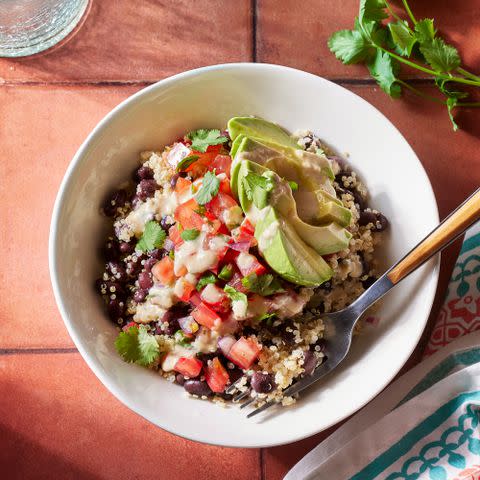

Photography: Carson Downing, Food Stylist: Holly Dreesman, Prop Stylist: Gabe Greco
Breakfast (368 calories)
A.M. Snack (105 calories)
Lunch (397 calories)
P.M. Snack (206 calories)
Dinner (500 calories)
Evening Snack (218 calories)
Daily Totals: 1,794 calories, 87g fat, 13g saturated fat, 99g protein, 178g carbohydrate, 48g fiber, 1,481mg sodium, 3,789mg potassium
Make it 1,500 calories: Change P.M. snack to 1 medium apple and omit pistachios at evening snack.
Make it 2,000 calories: Add 2 Tbsp. natural peanut butter to banana at the A.M. snack.
Day 6


Breakfast (424 calories)
A.M. Snack (105 calories)
Lunch (397 calories)
P.M. Snack (265 calories)
Dinner (406 calories)
Evening Snack (215 calories)
-
1 cup edamame, in pods
-
1 clementine
Daily Totals: 1,812 calories, 70g fat, 14g saturated fat, 121g protein, 195g carbohydrate, 42g fiber, 1,420mg sodium, 4,803mg potassium
Make it 1,500 calories: Omit Baked Banana-Nut Oatmeal Cups at P.M. snack and change evening snack to 1 medium orange.
Make it 2,000 calories: Add 2 Tbsp. natural peanut butter to banana at the A.M. snack.
Day 7


Photographer: Rachel Marek, Food stylist: Holly Dreesman, Prop stylist: Addelyn Evans
Breakfast (368 calories)
A.M. Snack (281 calories)
Lunch (397 calories)
P.M. Snack (188 calories)
Dinner (434 calories)
Evening Snack (116 calories)
Daily Totals: 1,783 calories, 82g fat, 12g saturated fat, 109g protein, 175g carbohydrate, 4122g fiber, 1,449mg sodium, 3,500mg potassium
Make it 1,500 calories: Omit pistachios at A.M. snack and omit evening snack.
Make it 2,000 calories: Add 2 Tbsp. natural peanut butter to evening snack.
Read the original article on Eating Well.
Source Agencies

